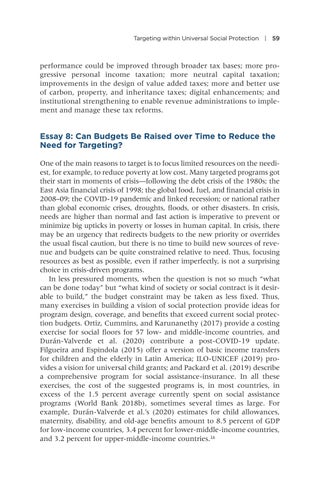Targeting within Universal Social Protection | 59
performance could be improved through broader tax bases; more progressive personal income taxation; more neutral capital taxation; improvements in the design of value added taxes; more and better use of carbon, property, and inheritance taxes; digital enhancements; and institutional strengthening to enable revenue administrations to implement and manage these tax reforms.
Essay 8: Can Budgets Be Raised over Time to Reduce the Need for Targeting? One of the main reasons to target is to focus limited resources on the neediest, for example, to reduce poverty at low cost. Many targeted programs got their start in moments of crisis—following the debt crisis of the 1980s; the East Asia financial crisis of 1998; the global food, fuel, and financial crisis in 2008–09; the COVID-19 pandemic and linked recession; or national rather than global economic crises, droughts, floods, or other disasters. In crisis, needs are higher than normal and fast action is imperative to prevent or minimize big upticks in poverty or losses in human capital. In crisis, there may be an urgency that redirects budgets to the new priority or overrides the usual fiscal caution, but there is no time to build new sources of revenue and budgets can be quite constrained relative to need. Thus, focusing resources as best as possible, even if rather imperfectly, is not a surprising choice in crisis-driven programs. In less pressured moments, when the question is not so much “what can be done today” but “what kind of society or social contract is it desirable to build,” the budget constraint may be taken as less fixed. Thus, many exercises in building a vision of social protection provide ideas for program design, coverage, and benefits that exceed current social protection budgets. Ortiz, Cummins, and Karunanethy (2017) provide a costing exercise for social floors for 57 low- and middle-income countries, and Durán-Valverde et al. (2020) contribute a post-COVID-19 update. Filgueira and Espindola (2015) offer a version of basic income transfers for children and the elderly in Latin America; ILO-UNICEF (2019) provides a vision for universal child grants; and Packard et al. (2019) describe a comprehensive program for social assistance-insurance. In all these exercises, the cost of the suggested programs is, in most countries, in excess of the 1.5 percent average currently spent on social assistance programs (World Bank 2018b), sometimes several times as large. For example, Durán-Valverde et al.’s (2020) estimates for child allowances, maternity, disability, and old-age benefits amount to 8.5 percent of GDP for low-income countries, 3.4 percent for lower-middle-income countries, and 3.2 percent for upper-middle-income countries.16


